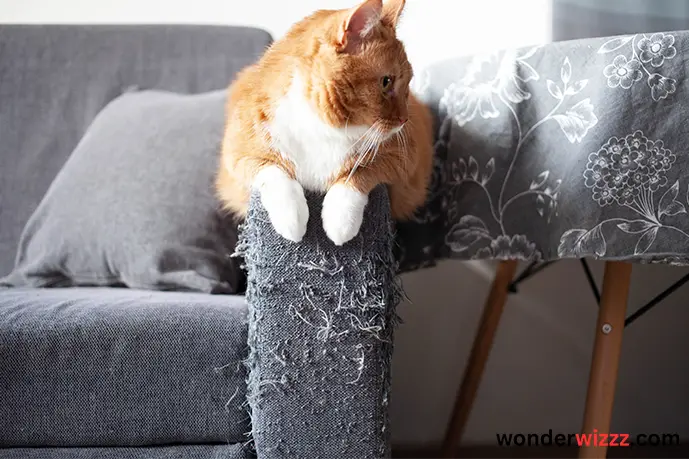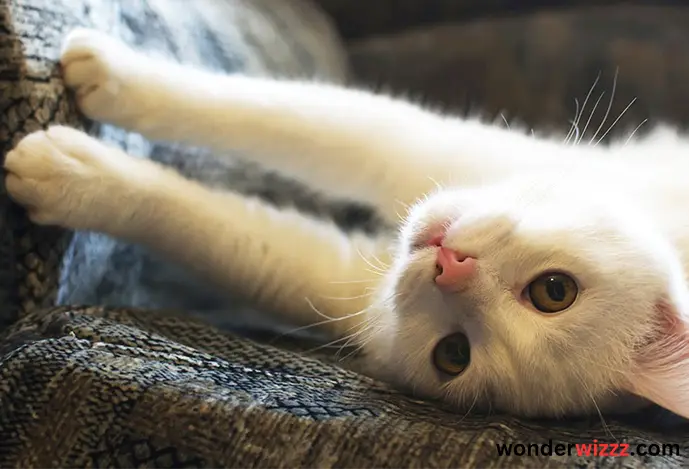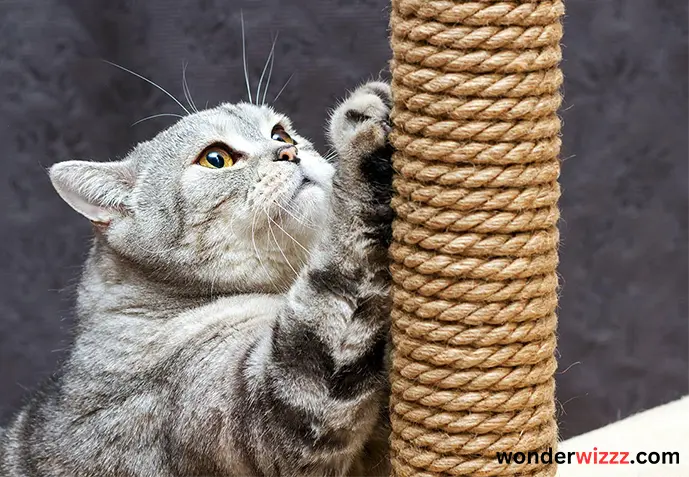How to Stop Your Cat from Scratching Furniture?

Introduction
A. Brief Overview of the Issue
When your cat scratches furniture, it can cause damage. Cats do this to mark their territory and keep their claws healthy. But, it’s a problem when they scratch things you don’t want them to.
B. Importance of Addressing This Behavior Early On
It’s essential to stop this behavior early because it can become a habit that’s hard to break. Plus, it saves your furniture from getting ruined. The earlier you start, the easier it is to teach your cat where it’s okay to scratch.
C. Preview of Strategies to Be Discussed
We’ll talk about different ways to prevent your cat from scratching furniture. From providing alternative scratching surfaces to using deterrents, there are several methods to explore. By trying these strategies, you can protect your furniture and keep your cat happy.

Understanding Cat Scratching Behavior
A. Instinctual Nature of Scratching in Cats
Cats scratch things because it’s natural for them. It’s like how humans need to stretch or yawn; scratching is a cat’s way of keeping their body and mind healthy.
B. Purpose of Scratching for Cats: Marking Territory, Stretching, Maintaining Claw Health
Scratching isn’t just about ruining your furniture. Cats scratch to mark their territory with scent glands in their paws. They also use scratching to stretch their muscles and tendons, kind of like a cat yoga session. Plus, scratching helps keep their claws sharp and healthy.
C. Common Materials Cats Prefer to Scratch On
Cats have their preferences when it comes to scratching surfaces. They often like things they can sink their claws into, like rough fabrics or textured materials. Cardboard scratchers and sisal rope are popular choices because they feel good on a cat’s claws and are easy to shred. Understanding what your cat likes to scratch on can help you provide suitable alternatives to your furniture.

Providing Suitable Alternatives
A. Introduction to Scratching Posts and Pads
Scratching posts and pads are like designated scratching spots for your cat. They give your cat a place to scratch that isn’t your furniture. Think of them as special scratching zones just for your cat.
B. Types of Scratching Posts: Vertical, Horizontal, Sisal, Carpeted
Vertical scratching posts stand upright like a tree, while horizontal ones lay flat on the ground. Sisal posts are made from a tough material that cats love to scratch, and carpeted posts have a soft surface that some cats prefer.
C. Placement of Scratching Posts for Maximum Effectiveness
Where you put scratching posts matters. Place them near where your cat likes to scratch already, like by their favorite napping spot or near the furniture they’ve been targeting. Make sure the posts are stable and won’t wobble or fall over when your cat uses them. This encourages your cat to choose the scratching post over your furniture.

Making Furniture Less Appealing to Cats
A. Use of Deterrents such as Double-Sided Tape or Aluminum Foil
Deterrents are things that make your cat not want to scratch furniture. Double-sided tape and aluminum foil are two examples. Cats don’t like the sticky feeling of tape on their paws or the crinkly sound of foil, so they’re less likely to scratch where you put them.
B. Incorporating Citrus Scents or Other Natural Repellents
Cats have sensitive noses and some scents they don’t like. Citrus smells, like lemon or orange, are often unpleasant to cats. You can use citrus-scented sprays or oils on furniture to discourage scratching. There are also other natural repellents like bitter apple spray that you can try.
C. Covering Furniture with Materials Cats Dislike
Sometimes covering furniture with things cats don’t like can stop them from scratching it. For example, you can cover your couch with a plastic or vinyl cover. Cats don’t usually enjoy scratching these materials, so they’ll look for somewhere else to scratch. Remember, it’s important to provide alternative scratching options along with deterrents to help your cat learn where it’s okay to scratch.

Positive Reinforcement Techniques
A. Rewarding Cats for Using Scratching Posts
Positive reinforcement means giving your cat something good when they do what you want. When your cat uses the scratching post instead of your furniture, give them a treat or praise them. This helps them learn that scratching the post is a good thing.
B. Using Toys and Treats to Redirect Scratching Behavior
Sometimes, cats scratch out of boredom or frustration. Giving them toys to play with or treats to munch on can redirect their energy away from scratching furniture. Interactive toys like feather wands or laser pointers can be especially engaging for cats.
C. Importance of Consistency and Patience in Training
Teaching your cat to use a scratching post requires patience and time. Be consistent with your methods and rewards. If you catch your cat scratching the furniture, gently redirect them to the scratching post. It may take some time for your cat to learn, so be patient and keep encouraging them. Remember, positive reinforcement works best when it’s consistent and paired with patience.
Environmental Enrichment and Behavioral Modification
A. Ensuring Cats Have Sufficient Mental and Physical Stimulation
Just like us, cats need things to keep them busy and happy. Make sure your cat has toys to play with, places to climb, and hiding spots to explore. This keeps their minds and bodies active, reducing the urge to scratch out of boredom or frustration.
B. Providing Alternative Activities to Scratching
If your cat is scratching furniture out of habit, try to distract them with other fun activities. Play with them using interactive toys, provide puzzle feeders for mental stimulation, or create a cozy cat-friendly environment with comfy beds and perches. The more options they have for entertainment, the less likely they are to resort to scratching.
C. Seeking Professional Help if Scratching Behavior Persists Despite Efforts
Sometimes, despite your best efforts, your cat may continue to scratch furniture. In such cases, it’s okay to seek help from a professional, like a veterinarian or a certified animal behaviorist. They can assess your cat’s behavior and provide personalized advice and strategies to address the issue. If you need assistance, don’t hesitate to seek help.
Conclusion
A. Recap of Key Strategies for Preventing Cat Scratching on Furniture
Remember, providing alternative scratching surfaces, using deterrents, positive reinforcement, and environmental enrichment are key strategies. By understanding your cat’s needs and behaviors, you can effectively prevent them from damaging your furniture.
B. Emphasis on the Importance of Understanding and Addressing Cats’ Natural Behaviors
Cats scratch for various reasons, including marking territory and maintaining claw health. Understanding why they scratch helps us find solutions that work for both cats and humans. By addressing their natural behaviors, we can prevent unwanted scratching and foster a harmonious relationship with our feline friends.
C. Encouragement for Cat Owners to Implement Proactive Measures for a Harmonious Home Environment
Preventing scratching behavior requires proactive measures and consistency. It’s essential to provide appropriate scratching alternatives, engage in positive reinforcement training, and create an enriched environment for your cat. With patience and dedication, you can create a happy and scratch-free home for both you and your cat.
People also ask
How do you scratch-proof furniture from cats?
Provide sturdy scratching posts and pads as alternatives to furniture.
How do you train a cat not to scratch?
Use positive reinforcement and redirect scratching to appropriate surfaces.
What scent keeps cats from scratching furniture?
Citrus scents like lemon or orange are often disliked by cats.
What can I spray on my couch to stop my cat from scratching?
Try cat deterrent sprays with bitter apple or citrus scents.
Is there a furniture fabric that cats won’t scratch?
Sisal or tightly woven fabrics are less appealing to cats.
Does trimming a cat’s nails help with scratching?
Trimming nails can reduce scratching damage but won’t stop scratching behavior completely.



